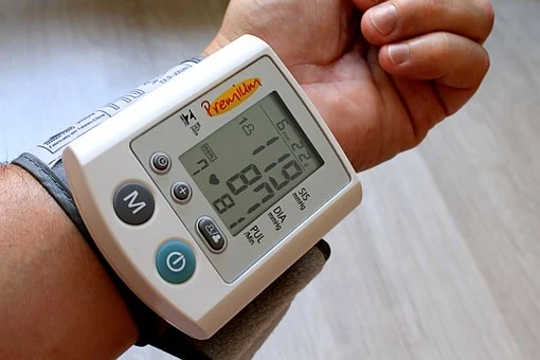
Image by Adriano Gadini
The Heart Foundation in Australia launched new national guidelines on the management of high blood pressure (hypertension). There are several changes since the last edition, but the one making headlines is a lower blood-pressure target. Instead of aiming for a (systolic) target of 140 in most people with hypertension, 120 is recommended for many.
On a careful read, the changes seem cautious and well-aligned with recent evidence.
But a danger of reducing the new BP target to a headline is it might sound like we should be getting everyone’s blood pressure down to 120. That’s definitely not what the new guidelines say, or what the evidence supports. It’s complex, and here I’ll try to explain the details.
What is high blood pressure, and why worry about it?
Blood pressure is the force with which blood pushes on the walls of the arteries in the body. With every beat of the heart, this pressure swerves up, and its maximum is called the systolic blood pressure. Then, as the heart relaxes between beats, the pressure falls, and its minimum is called the diastolic blood pressure. Combining these two measurements yields the familiar top/bottom blood-pressure numbers – for example, 120/80, which is a textbook “normal” reading.
Get The Latest By Email
Hypertension is defined as a resting blood pressure consistently above 140/90, over several occasions. We need several readings because blood pressure is fickle, changing for many reasons. One is the “white coat effect” of being in a room with a doctor. For this reason, the new guidelines also emphasise the importance of blood-pressure measurements taken automatically by a machine, and often elsewhere than in a doctor’s office.
Hypertension is a major risk factor for cardiovascular diseases such as heart attack and stroke. Medicines to reduce blood pressure (antihypertensives) can prevent some of these nasty events.
How much we worry about the risks posed by hypertension depends in part on how high the blood pressure is – the higher it is, the higher the risk. People who have already had a heart attack or stroke are obviously at high risk of another. But there are many other risk factors too, including age, gender, smoking, diabetes and cholesterol levels.
For people who haven’t already had a heart attack or stroke, calculating “absolute cardiovascular risk” is usually a good idea. This is done by plugging average blood pressure, age and so on into a special calculator (like cvdcheck.org.au or QRisk). The higher the absolute risk, the more likely antihypertensives are to be helpful.
Blood-pressure treatment targets, and the new evidence
Blood-pressure targets have changed a lot over time. An older colleague of mine remembers being taught years ago that an acceptable systolic pressure was “100 plus your age”.
For several decades, a target of below 140/90 has been recommended for most patients. A tighter target for people with diabetes came, then went, as one trial seemed to support it, then a bigger trial refuted it. There have also been changing targets for other groups of people, such as those with kidney disease. I’ve sensed some weariness about these “shifting goalposts” among fellow doctors.
The trigger for the new 120 systolic target is an important new trial called SPRINT, which was published late last year. Nearly 10,000 people with hypertension were randomly assigned to either a 120 or a 140 systolic blood-pressure target. The average systolic pressures achieved were 121.4 and 136.2 respectively.
After just over three years, there were significant differences between the two groups, with fewer heart attacks and deaths in the group aiming for a blood pressure of 120.
But the devil is in the detail. First, the people in the SPRINT study were not at low risk – they were all at least 50 years old (average age 68) and had, on average, a calculated 10-year absolute cardiovascular risk of about 20%. So the results can’t be confidently applied to younger patients or lower-risk patients.
Second, the trial did not include anyone with diabetes, anyone with past stroke, or anyone living in a nursing home. So again, the results can’t be applied to these groups.
Third, the trial was stopped earlier than anticipated due to convincing early evidence of benefit. This is reasonable on ethical grounds, so as not to keep subjecting the 140 target group to their inferior treatment. But trials stopped early may overestimate how well treatments work.
Fourth, the proportion of people who benefited was not large. Over the course of the study, about 60 people had to be treated (to the 120 target instead of 140) for every nasty heart or brain event prevented, and 90 people for every death averted.
Fifth, there were a few more harms in the group with the 120 target, such as fainting, blood chemistry (electrolyte) problems and kidney injury. (Having said that, these were few in number too, and many of these harms are more minor than the benefits above.)
Wisely, our new national guidelines acknowledge many of these caveats. They don’t advocate “120 for everyone”. They confine the 120 target to people like those in the SPRINT trial, with significantly raised cardiovascular risk and without diabetes or past stroke. And they advise watching carefully for the side effects seen in SPRINT.
What to do
If you have hypertension, you may be wondering what you should do. Because this is complicated, it’s wise to talk to your doctor. A conversation could include estimating your absolute risk and considering whether you are the sort of person the SPRINT trial suggests might benefit.
Be aware this is a very recent guideline change, and many of us doctors are still grappling with the evidence and feeling a bit uncertain about the new targets. Whether to aim for the new low target will depend not just on your level of risk but also your own preferences and values.
I’m particularly uncertain about whether to suggest a 120 target to my frail older patients. The SPRINT trial did show benefits in those over 75, including some “frail” people. But as people in nursing homes were not included, I’m still a bit wary of low targets in this group. I would discuss my uncertainty with such people (or their decision-makers), explore their goals and reach a shared decision.
I’m also uncertain just how many medicines I should prescribe to try to reach 120. Antihypertensives tend to be added incrementally – if one isn’t enough, we add another. In SPRINT, the average person aiming for 120 ended up on about three antihypertensive drugs.
But some of my patients won’t make the 120 target even after four antihypertensive drugs. I’m not at all confident I should combine more than three or four antihypertensives, as evidence of benefit of such combinations is sparse.
People who try to reach 120 but can’t get there needn’t panic. In terms of risk reduction, getting to 120 is “the icing on the cake”. Any reduction in blood pressure, if achieved by well-proven antihypertensives, is likely to reduce risk somewhat, regardless of targets.
And there are other ways to reduce risk. These include lifestyle changes (quitting smoking, exercising, having a healthy diet, avoiding excessive salt and alcohol) and sometimes with other medicines (such as statins).
About the Author
Brett Montgomery, Senior Lecturer in General Practice, University of Western Australia
This article is republished from The Conversation under a Creative Commons license. Read the original article.
books_health








